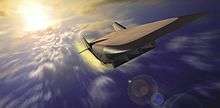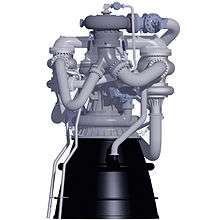Space Launch Initiative
The Space Launch Initiative (SLI) was a NASA and U.S. Department of Defense joint research and technology project to determine the requirements to meet all the nation's hypersonics, space launch and space technology needs. It was also known as the 2nd Generation Reusable Launch Vehicle (RLV) program.[1] The program began with the award of reusable launch vehicle study contracts in 2000.[1]

The primary goal of this research was to increase safety and reliability and to reduce overall costs associated with building, flying and maintaining the nation's next generation of space launch vehicles. NASA anticipated that these advances would revitalize the nation's space transportation capabilities, and dramatically improve NASA's ability to conduct science and exploration missions in space.[2] This program was ended with the cancellation of the X-33 and X-34 in 2001 along with the conclusion of the X-43 program. In November 2002 it was evolved into the Orbital Space Plane Program and the Next Generation Launch Technology Program.[3]
Around 2004 NASA changed its focus to Constellation Program, as part of the Vision for Space Exploration.
The Space Launch Initiative Propulsion Office, managed by NASA's Marshall Space Flight Center in Huntsville, Alabama, sought to advance technologies and explore new avenues of space propulsion to develop safer, more reliable and affordable propulsion solutions. Four main engine candidates for a second generation reusable launch vehicle emerged, including two hydrogen-fueled (COBRA, RS-83, TR-106) and two kerosene-fueled (RS-84, TR-107) staged combustion cycle engines.
COBRA rocket engine
"Co-optimized Booster for Reusable Applications".[4]:139 Propulsion system proposed by Pratt & Whitney-Aerojet Propulsion Associates to cover a wide range of thrust. This LH2/LOX reusable rocket engine was designed in 2003 to produce 4,500 kN thrust. Proposed as a long-life, moderate-to high-thrust, reusable booster engine that incorporated a safe, low-cost, low-risk, LH2/LOX single burner, using a fuel-rich, staged combustion cycle.[4]:141
RS-83 rocket engine
The RS-83 was a rocket engine design for a reusable LH2/LOX rocket larger and more powerful than any other. The RS-83 was developed by Rocketdyne Propulsion and Power in Canoga Park, California to power the launch vehicle as part of the Space Launch Initiative program. This engine was designed to produce a thrust of 664,000 lbf (2,950 kN) at sea level and 750,000 lbf (3,300 kN) in a vacuum with an Isp of 395 and 446 seconds (3.87 and 4.37 kN·s/kg), respectively.[4]:139
The RS-83 is loosely based on the RS-68 that powers the Delta IV expendable launch vehicle. The RS-83 design is more efficient, lighter, slightly stronger, and yet reusable. The RS-83 was designed to last 100 missions, and was intended for use on the first stage of a two-stage-to-orbit reusable launch vehicle.
RS-84 rocket engine

As part of the Space Launch Initiative, Rocketdyne developed a plan for the RS-84 rocket engine. It would have been the first reusable, staged combustion cycle, liquid rocket engine produced by the US to use a hydrocarbon fuel.[5] In contrast, the Soviet Union developed the RD-170 reusable staged combustion hydrocarbon engine for the Energia rocket in the 1980s.
The prototype engine would have 4,732 kN (1,064,000 lbf) at sea level; 5,026 kN (1,130,000 lbf) in vacuum; an 8-shift turn time; a specific impulse of 305 at sea level and 324 in vacuum.[4]:141
NASA cancelled further development in 2005.[6]
TR-106 / TR-107 rocket engines
The TR-106 or Low Cost Pintle Engine (LCPE) was a developmental LH2/LOX rocket engine designed by TRW under the Space Launch Initiative. It had a planned sea-level thrust of 650,000 lbf.[4]:144 It was tested at NASA John C. Stennis Space Center throughout 2000. The Stennis test stand results demonstrated that the engine was stable over a wide variety of thrust levels and propellant ratios.[7] Development of the engine was temporarily discontinued with the cancellation of the Space Launch Initiative.[7]
Since 2000, TRW has been acquired by Northrop Grumman and development of the TR-107 RP-1/LOX rocket engine began in 2001 for potential use on next-generation launch and space transportation vehicles is continuing under contract to NASA.[8][9]
Technology lessons from the Low Cost Pintle Engine project assisted subcontractor development of engines by SpaceX.
Air Force Reusable Booster Program
The Air Force Reusable Booster System program initiated in 2010, and cancelled in 2012, was hoped to renew interest in further development of these engines.[10]
See also
References
- "Space Launch Initiative fact sheet". NASA. April 2002.
- "The Next Generation Launch Technology Program" (wikisource). NASA, May 2003.
- "The Next Generation Launch Technology Program" (PDF). NASA. May 2003.
- A Review of United States Air Force and Department of Defense Aerospace Propulsion Needs. 2006
- "RS-84 Rocket Engine Overview" (PDF). Rocketdyne. April 2003. Archived from the original (PDF) on 2008-07-04.
- "RS-84 Next Generation Launch Technology (NGLT) Testing". NASA. July 24, 2009.
- TR-106 on astronautix Archived 2013-12-30 at the Wayback Machine
- "Booster Engine Prototype Project" (PDF). NASA. Nov 2003.
- Northrop Grumman booster vehicle engines Archived 2010-05-23 at the Wayback Machine
- "Air Force studying reusable upper stage systems for reusable booster". RLV and Space Transport News. September 2010. Archived from the original on 2011-07-24.
External links
- "GAO-02-1020: Challenges Facing NASA's Space Launch Initiative". GAO. September 2002. Archived from the original (PDF) on 2012-12-12.
- Main Engines of SLI program NASA Sept 2002
- "RS-84" Encyclopedia Astronautica
- RS-84 Engine Passes Preliminary Design Milestone Space Daily, Jul 16, 2003
- Boeing Tests Future Rocket Engine Component to Record Levels Space Daily, Dec. 11, 2003
- NASA FY 2004 operating plan - page 6, cancellation of RS-84
- A Review of United States Air Force and Department of Defense Aerospace Propulsion Needs. 2006